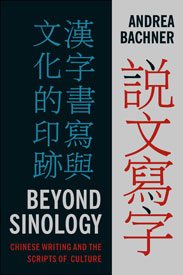Book explores new resurgence of Chinese script
By Kathy Hovis

In recent decades, Chinese script has become a kind of national symbol: Buildings are designed to look like Chinese characters, and characters often play a key role in public ceremonies, such as the 2008 Beijing Olympics. At the same time, experiments with Chinese script also challenge a monolithic Chinese identity.
That’s a far cry from the 19th and early 20th century, when reform movements within China pushed for a change to a more alphabetic script, says Andrea Bachner, assistant professor of comparative literature in the College of Arts and Sciences.
Bachner’s first book, “Beyond Sinology: Chinese Writing and the Scripts of Culture” (Columbia University Press, 2014), explores how interest in Chinese script has exploded in recent times in literature, film, visual and performance art, as well as design and architecture.
“There is a new triumphalist narrative connected to the Chinese script,” Bachner said. “It’s very evident in the context of events like the Beijing Olympics or the 2010 Shanghai expo that showcase China’s role on the world stage. The characters are deployed as a marker of Chinese essence, of China’s unique heritage.”
Often considered a system not suited for modern times, reformers insisted that Chinese script had too many “letters” or characters, took too long to learn, and did not accurately represent speech.
But in 1949, after the Communist victory on mainland China, the language reform movement died away. Today’s resurgence of the character focuses on its suitability for use in today’s digital world, Bachner said, where everything is converted to bits and bytes, whether alphabetic or character-based.
Bachner lived in Taiwan for several months at a time during the last few years, conducting research in libraries, bookstores, exhibits and art galleries. Her book includes case studies on the ways Chinese script is used in tattooing, film, concrete poetry, new digital media and the Internet, among other areas.
One movement she explores is “Martian script,” a new Chinese script developed by young Chinese for use on the Internet.
“It doesn’t make inputting any easier, but it’s a way to set this group apart,” she said. “The parents probably would not understand what their children are texting.”
Bachner said the evolution of the script in China is emblematic of a process that all languages and writing systems experience: “Script systems and languages are open and flexible and are not monolithic representations of national or cultural identity. Chinese is a good example of what all languages go through, but its very graphic characters make it interesting because of its connection to other media.”
Bachner believes that the beauty of Chinese characters is here to stay.
“Writing is still a complex and very modern medium, in spite of all the new media and people who say that writing is dying and will someday be replaced by code,” she said.
Kathy Hovis is a writer for the College of Arts and Sciences.
Media Contact
Get Cornell news delivered right to your inbox.
Subscribe